![]()
![]()
![]()
Use LEFT and RIGHT arrow keys to navigate between flashcards;
Use UP and DOWN arrow keys to flip the card;
H to show hint;
A reads text to speech;
117 Cards in this Set
- Front
- Back
|
Define anatomy
|
science of structure
|
|
|
Define physiology
|
science of body functions
|
|
|
Name three key clinical observational techniques
|
palpation
auscultation percussion |
|
|
What are the 6 levels of anatomical organisation?
|
chemical
cellular tissue organs systems oranism |
|
|
What are the 6 key life processes?
|
metabolism (sum of all chemical processes)
responsiveness (homeostasis) movement growth differentiation (cellular) reproduction |
|
|
What is anatomical position
|
standing upright
facing observer eyes facing forward arms at sides palms turned forwards |
|
|
What is prone position?
|
Lying face down
|
|
|
What is supine position?
|
Lying face up
|
|
|
What is a plane?
|
An imaginary flat surface that passes through the body
|
|
|
What is a section?
|
A section results when a plane is cut through the body
|
|
|
Describe the saggital plane
|
* divides the body into left and right sides
* midsaggital produces equal halves * parasaggital produces unequal halves |
|
|
Describe the frontal (coronal) plane
|
divides the body/organ into front (anterior) and back (posterior)
|
|
|
Describe the transverse plane
|
divides the body/organ into upper (superior) and lower (inferior) portions
|
|
|
Describe the oblique plane
|
a plane at an oblique angle
|
|
|
Define superior
|
higher
|
|
|
Define inferior
|
lower
|
|
|
Define dorsal (posterior)
|
at the back
|
|
|
Define ventral (anterior)
|
at the front
|
|
|
Define medial
|
nearer to the midline of the body
|
|
|
Define lateral
|
farther from the midline of the body
|
|
|
Define proximal
|
nearer to the attachment of the limb to the trunk
|
|
|
Define distal
|
farther from the attachment of the limb to the trunk
|
|
|
What is a body cavity?
|
space within the body that protects, separates and supports internal organs
|
|
|
Define the dorsal cavity
|
1) cranial cavity, holds the brain, formed by skull
2) vertebral canal, contains the spinal cord |
|
|
Define the ventral body cavity
|
1) thoracic cavity above diaphragm
2) abdominopelvic cavity below diaphragm |
|
|
Define serous
|
2 layers with fluid in between
|
|
|
Define mediastinum
|
Everything in the thoracic cavity that is not the lungs
|
|
|
Describe the saggital plane
|
* divides the body into left and right sides
* midsaggital produces equal halves * parasaggital produces unequal halves |
|
|
Describe the frontal (coronal) plane
|
divides the body/organ into front (anterior) and back (posterior)
|
|
|
Describe the transverse plane
|
divides the body/organ into upper (superior) and lower (inferior) portions
|
|
|
Describe the oblique plane
|
a plane at an oblique angle
|
|
|
Define superior
|
higher
|
|
|
Define inferior
|
lower
|
|
|
Define dorsal (posterior)
|
at the back
|
|
|
Define ventral (anterior)
|
at the front
|
|
|
Define medial
|
nearer to the midline of the body
|
|
|
Define lateral
|
farther from the midline of the body
|
|
|
Describe the abdominopelvic regions
|
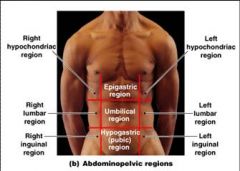
See image
|
|
|
What is the cell membrane?
|
A flexible but sturdy, semipermeable barrier that surrounds the cytoplasm of a cell
|
|
|
Describe the cell membrane
|
Sea of phospholipids on which proteins float like icebergs
|
|
|
What is a phospholipid?
|
Hydrophilic head (phospho) + hydrophobic tail (lipid)
|
|
|
What are membrane proteins used for?
|
Ion channels (ie, Na+)
Transporters (like ion channels) Receptors Enzymes (catalysts) Linkers (within/outside cell) Identity markers (ie blood type, immune system) |
|
|
What is the cytoplasm?
|
Cytosol + organelles (except nucleus)
|
|
|
Draw a cell and label:
1. cell membrane 2. nucleus 3. cytoplasm 4. smooth ER 5. rough ER 6. ribosome 7. mitochondrion 8. lysosome 9. golgi complex |
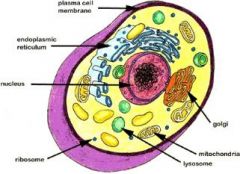
As per image
|
|
|
What are organelles?
|
Specialised structures within the cell with characteristic shapes and functions
|
|
|
What is the cytoskeleton?
|
made up of proteins:
* microfilaments * intermediate filaments * macrotubules Shape and motion |
|
|
What is the centrosome?
|
Organelle that plays a critical role in cell division
|
|
|
What are cilia?
|
short, hair-like projections
ie - respiratory tract, fallopian tubes... Move substances across the surface of the cell |
|
|
What are flagella?
|
Longer projections that can move an entire cell - ie, sperm
|
|
|
What are ribosomes?
|
* sites of protein synthesis
* located on rough ER, in cytoplasm and in mitochondria * spherical |
|
|
What is the endoplasmic reticulum?
|
* network of membranes surrounding nuclear membrant
* rough ER and smooth ER |
|
|
What is the rough ER?
|
Has ribosomes attached - site of protein synthesis
|
|
|
What is the smooth ER?
|
No ribosomes attached - site of synthesis of fatty acids and steroids
|
|
|
What is the golgi complex?
|
* Looks like a stack of pancakes with bits budding off on the ends
* modify, sort and package proteins for transport to different destinations |
|
|
What are lysosomes?
|
* Spherical
* membranous vesicles filled with digestive enzymes * digest foreign substances, autophagy & autolysis |
|
|
What is the mitochondria?
|
* powerhouse of the cell
* responsible for energy production * may have 100s or 1000s in each cell depending on energy requirements * transforms sugar and oxygen into energy * capsule shaped with an outer and an innner membrane |
|
|
What is the nucleus?
|
* The "director" of cellular activities
* most cells have single nucleus * contains cell's genetic material (DNA, made of chromasomes) |
|
|
Describe the nucleus
|
double membrane
outer membrane continuous with rough ER nucleoli produces ribosomes |
|
|
What is the role of protein in the cell?
|
structure
hormones antibodies enzymes |
|
|
How does protein synthesis occur?
|
1) Genetic info in DNA is copied by mRNA (TRANSCRIPTION) and mRNA leaves the nucleus
2) In the cytoplasm/rough ER, mRNA attaches to a ribosome and TRANSLATES the DNA to form proteins |
|
|
What are cell junctions?
|
contact points between cell membranes of tissue cells
|
|
|
What are the 4 types of cell junctions?
|
tight junctions
adherens junctions desmosomes & hemidesmosones gap junctions |
|
|
What is a tight junction?
|
weblike
prevents contents from leaking into surrounding areas stomach, intestines, bladder... |
|
|
What are adherens junctions?
|
holds epithelial cells together
|
|
|
What are desmosomes and hemidesmosomes?
|
similar to adherens junctions
hemi = half |
|
|
What are gap junctions?
|
Tiny space between plasma membranes of 2 cells
Permit electrical and chemical mesages to pass between cells |
|
|
List the 4 types of tissue.
|
Epithelial
connective muscular nervous |
|
|
Where would you find epithelial tissue?
|
covers body surfaces
forms glands lines hollow organs (lumens), cavities and ducts |
|
|
Describe epithelial tissue.
|
* Avascular
(gets nutrients from underlying connective tissue) * covering/lining & glandular types * good nerve supply * rapid cell division (heals well) * 1 layer if absorbtion happens * multiple layers if it is in a high traffic area |
|
|
How are covering/lining epithelia described
|
1) as simple (1 layer) or stratified (multiple layers)
AND 2) as squamous (flat) cuboidal (cube shaped) columnar (column shaped) transitional (can change shape) |
|
|
What is glandular epithelium?
|
* Makes up secreting portion of glands
* Endocrine glands secrete hormones (adrenal glands, thyroid glands...) * Exocrine glands may secrete mucus, sweat, oil, earwax, saliva, digestive enzymes... |
|
|
What is connective tissue?
|
* Binds, supports & strengthens other body tissues
* protects & insulates internal organs * compartmentalises structures * does not usually occur ON body surfaces * highly vascular * nerve supply * includes blood, bones, fat, cartilage * 2 basic elements - cells + extracellular matrix consists |
|
|
What is the extracellular matrix in connective tissue?
|
Protein fibres & ground substances between widely spaced cells
ie: in blood, plasma = extracellular matrix. Consists of cells, water and albumin (protein). |
|
|
Do cells in connective tissue touch?
|
* rarely touch as they are produced and separated by extracellular matrix
|
|
|
What are the types of connective tissue?
|
1) loose - fluid like, subcutaneous layer, adipose tissue
2) dense connective tissue - thicker, denser, tendons & ligaments 3) cartilage 4) bone 5) blood 6) lymph |
|
|
What are the two types of membranes?
|
1) epithelial membrane = epithelial layer plus underlying connective tissue layer (ie, mucous membranes, skin...)
2) synovial membrane = lines joints, contains connective tissue but no epithelium |
|
|
What does muscle tissue do?
|
posture
movement generation of heat |
|
|
What are the 3 types of muscle tissue?
|
1) skeletal - voluntary, manu nucleated, striated appearance, cylindrical
2) cardiac - involuntary, only in heart, striated, one nucleus, step-like appearance 3) smooth - inside intestines, bladder etc. Involuntary, NOT striated, tapered ends, one nucleus. |
|
|
What are the functions of nervous tissue?
|
sensory
integration motor |
|
|
What are the cell types in nervous tissue?
|
1) neurons - cell body, tree like endings to receive messages
2) neuroglia - support cells for neurons |
|
|
What is homeostasis?
|
condition of equilibrium in the body's internal environment
|
|
|
Why is homeostasis important?
|
Continually being disrupted by external (heat cold, lack of oxygen) and internal stimuli (psychological stresses, exercise)
If it's not maintained, death may result |
|
|
How does homeostasis work?
|
Feedback loop:
* receptors monitor controlled condition * control centre determines next action * effector produces a response that changes the controlled condition |
|
|
Describe the two types of feedback system.
|
1) negative feedback = opposing the action that is disrupting homeostasis
2) positive feedback = increases change that is causing disruption, ie childbirth |
|
|
What are the 11 systems of the human body?
|
1. integumentary
2. skeletal 3. muscular 4. nervous 5. endocrine 6. lymphatic 7. cardiovascular 8. respiratory 9. digestive 10. reproductive 11. urinary |
|
|
What is a disorder?
|
Abnormality of function
|
|
|
What is a disease?
|
homeostatic imbalance with distinct symptoms and signs
|
|
|
Define diagnosis
|
skill of distinguishing one disease from another
|
|
|
Define epidemiology
|
Study of disease on a population level
|
|
|
Define pharmacology
|
how drugs are used to treat disease
|
|
|
How is the nervous system organised?
|
* Central NS = brain and spinal chord
* peripheral NS = sensory and motor nerves, including: cranial nerves spinal nerves peripheral nerves sensory nerves enteric nervous system |
|
|
What are the 3 basic functions of nervous tissue?
|
1. sense changes (receptors)
2. interpret and remember changes 3. react to changes (effectors) |
|
|
Show how the nervous system is organized by drawing an org chart
|
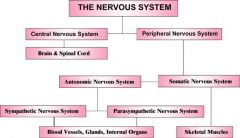
See image
|
|
|
What are the subdivisions of the PNS?
|
1. Somatic (voluntary) NS (SNS)
2. Autonomic (involuntary) NS (ANS) 2a) sympathetic division (fight/flight) 2b) parasympathetic division (rest/digest) 3. Enteric NS |
|
|
Name and label the parts of the brain
|

See image
|
|
|
Describe the brain
|
* largest organ
* 4 main parts - brain stem, cerebellum, cerebrm, diencephalon * 2 hemispheres - R&L, separated by corpus collosum |
|
|
What does the brain do?
|
Receives sensory input
integrates new and stored info makes decisions causes motor activities |
|
|
Describe the brain stem
|
* major pathway from brain to lower body
* makes sure basic bodily functions happen, ie breathing * medulla oblongata (bottom) * pons (middle) * midbrain (top) |
|
|
Describe the cerebellum
|
*2nd in size to cerebrum
*contains nearly 1/2 neurons in brain * compares what we're doing with what we think we're doing * enables coordination |
|
|
Describe the diencephalon
|
* Between brainstem and cerebrum
* thalamus, hypothalamus, epithalamus * emotioal responses * control centre for ANS |
|
|
Describe the cerebrum
|
AKA cortex
*2 hemispheres (R&L) * L hemi for R side of body *4 lobes (frontal, parietal, temporal, occiputal) *seat of intelligence - higher functions, decision making, judgement, vision, copying, hearing... * grey matter overlying white matter * folds = gyrus (pl. gyri) * grooves = sulcus (sulci) if small, fissure if large * corpus callosum connects hemispheres |
|
|
Describe cranial nerves
|
12 pairs
pass through bones of skull PNS *voluntary & involuntary muscle control *glandular tissue |
|
|
What is the spinal chord?
|
Extension of the brain
within vertebral column for travel of sensory & motor info * protected by bony vertebrae, meninges (connective tissue) & CFS) |
|
|
Describe the spinal nerves?
|
31 pairs - mixed sensory & motor
8 cervical 12 thoracic 5 lumbar 5 sacral |
|
|
Describe the branching of spinal nerves
|
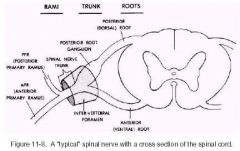
* dorsal (sensory) & ventral (motor) roots next to spinal cord
* roots come together and then branch out again as rami * dorsal rami supply skin and muscles of back * ventral rami supply muscles and structures of limbs and skin |
|
|
What is histology?
|
Study of cells
|
|
|
How many types of cells are there in the Nervous System?
|
2 - neurons and neuroglia
|
|
|
What are neurons?
|
* specialised cells found in the CNS and nerves and ganglia of the PNS
|
|
|
What do neurons do?
|
process and transmit information
|
|
|
Describe the structure of a neuron.
|
* cell body = contains all the things you would find in "normal" cell
* dendrites = conduct impulses towards the cell body (receiving information). Typically short, highly branched, unmyelinated * axon = conduct impulses AWAY from cell; transmission lines of the NS * |
|
|
Draw and lable an axon, including:
* cell & nucelus * dendrites * axon hillock * axon * Schwann cells & nuclei * node of Ranvier * synaptic end bulbs |
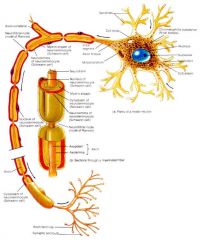
See image
|
|
|
What are neuroglia?
|
*non-neuronal cells
*provide support & nutrition * maintain homeostasis * participate in signal transmission * comprise half the volume of the CNS * can divide (neurons don't) |
|
|
Name and describe 4 types of neuroglial cells in CNS
|
1) astrocytes = star shaped, cover blood capillaries to for blood-brain barrier
2) oligodendrocytes (most common) = forms myelin sheath around axons in CNS 3) microglia = phagocytosis 4) ependymal cells = produce CSF, form epithelial membrane lining cerebral cavities & central canal |
|
|
Name and describe two types of neuroglial cells in PNS
|
1) satellite = flat cells surrounding neuronal cell bodies in peripheral ganglia
2) Schwann cell - wrap around PNS axons to produce myelin sheath |
|
|
What is myelination?
|
* Process of forming a myelin sheath
* myelin sheath = lipid & protein covering * gaps in myelination called nodes of Ranvier * creates insulation to speed up conduction of nerve impulses |
|
|
What is white matter?
|
myelinated processes
|
|
|
What is grey matter?
|
nerve cell bodies
dendrites axon terminals unmyelinated axons neuroglia In spinal cord, grey matter = H shaped inner core In brain, grey matter = thin outer shell covers surface of the brain |

